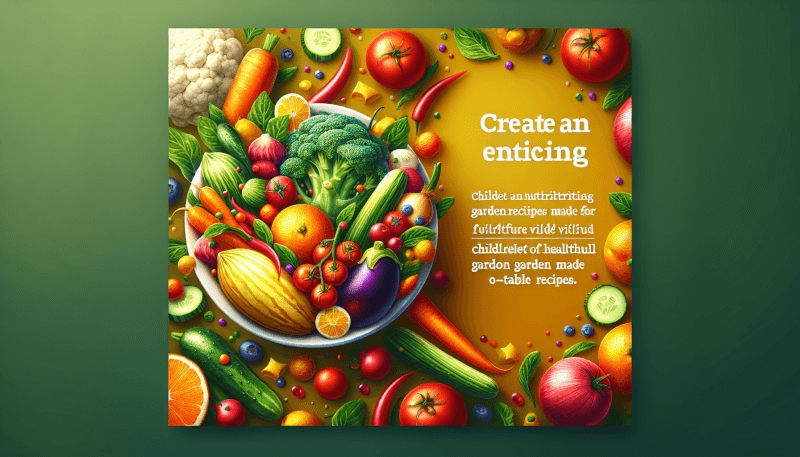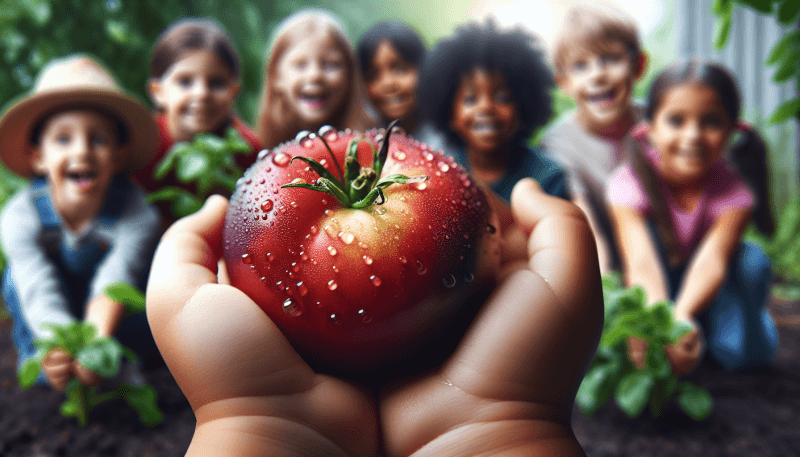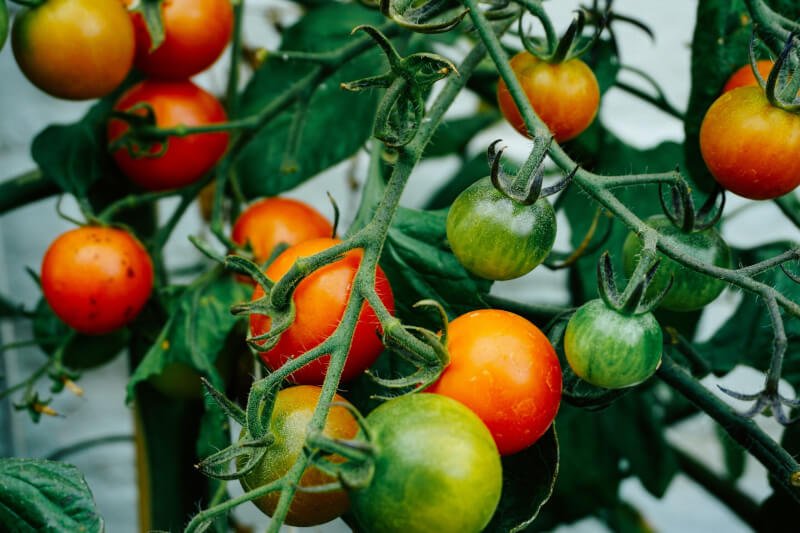Imagine a world where children are excited to eat their vegetables. It may seem like a distant dream, but with the right recipes, it can become a reality. In this article, we will explore a collection of healthy garden recipes that are not only nutritious but also delicious. From rainbow veggie wraps to fruity cucumber boats, these recipes will not only satisfy your child’s taste buds but also encourage them to explore the wonders of fresh produce. So, let’s embark on this culinary adventure and discover the joy of healthy eating together!

The Benefits of Gardening with Kids
Gardening with kids is not only a fun and engaging activity, but it also offers numerous benefits for their development. By spending time in the garden, children have the opportunity to learn about plants and nature, develop healthy eating habits, and build important skills like responsibility and patience.
Learning about plants and nature
Gardening is a great way for kids to learn about plants and the natural world around them. They can observe the different stages of plant growth, from planting seeds to caring for seedlings and eventually harvesting fruits and vegetables. Through gardening, children can also become more aware of the importance of environmental sustainability and the interconnections between plants, insects, and animals. It’s an excellent hands-on learning experience that can spark their curiosity and deepen their understanding of the natural world.
Developing healthy eating habits
One of the wonderful benefits of gardening with kids is that it encourages them to eat a wider variety of fruits and vegetables. When children are involved in growing their own food, they develop a sense of pride and excitement about eating the fruits of their labor. They are more likely to try new vegetables and fruits and develop a taste for fresh, wholesome foods. Gardening also provides an opportunity to discuss the nutritional benefits of different foods and reinforce the importance of a balanced diet.
Building responsibility and patience
Gardening requires patience, perseverance, and responsibility. When children take care of a garden, they learn the importance of regular watering, weeding, and providing proper care for the plants. They develop a sense of responsibility towards their garden and understand that their actions directly impact the growth and health of the plants. Gardening also teaches patience as children wait for their plants to grow and bear fruits. Learning to wait for the rewards of their efforts can be a valuable life lesson for kids.
Getting Started with a Kids’ Garden
Starting a kids’ garden can be an exciting and rewarding experience. It provides children with a sense of ownership and allows them to actively participate in every step of the gardening process. Here are some essential steps to help you get started with a kids’ garden:
Choosing the right location
The first step in starting a kids’ garden is selecting the right location. Look for a spot in your yard that receives adequate sunlight. Most vegetables and herbs require at least six hours of direct sunlight per day. If you don’t have a suitable outdoor space, consider container gardening or utilizing a community garden.
Deciding on the type of garden
There are several types of gardens to choose from, depending on the available space and your preferences. You can opt for a traditional in-ground garden, raised beds, or even vertical gardens if space is limited. Raised beds are an excellent option for kids as they provide a designated area for gardening and can be easily accessed.
Preparing the soil
Before planting, it’s essential to prepare the soil properly. Remove any weeds or grass from the area and loosen the soil with a garden fork or tiller. You may also need to amend the soil with compost or organic matter to improve its fertility and drainage. Involving your kids in soil preparation can be a great way to teach them about the importance of proper soil health.
Selecting easy-to-grow plants
To ensure a successful gardening experience, start with easy-to-grow plants that are suitable for the local climate. Some great options for a kids’ garden include cherry tomatoes, carrots, radishes, lettuce, and herbs like basil and mint. These plants grow relatively quickly and produce noticeable results, keeping your kids engaged and excited about gardening.

Delicious Garden Snacks for Kids
When the garden starts producing fresh vegetables and fruits, it’s time to enjoy some delicious and healthy garden snacks with your kids. Here are a few simple recipes that highlight the flavors of garden-fresh produce:
Cucumber and Carrot Salad
Ingredients:
- 1 cucumber, sliced
- 2 carrots, grated
- 1 tablespoon fresh lemon juice
- 1 tablespoon olive oil
- Salt and pepper to taste
Instructions:
- In a bowl, combine the sliced cucumber and grated carrots.
- Drizzle the lemon juice and olive oil over the vegetables.
- Season with salt and pepper according to taste.
- Toss everything together until well coated.
- Serve immediately and enjoy the refreshing crunch of this garden-fresh salad.
Zucchini Pizza Bites
Ingredients:
- 2 medium-sized zucchini, cut into thick slices
- Tomato sauce
- Shredded mozzarella cheese
- Your choice of pizza toppings (e.g., sliced cherry tomatoes, chopped bell peppers, sliced olives)
Instructions:
- Preheat your oven to 375°F (190°C).
- Place the zucchini slices on a baking sheet lined with parchment paper.
- Spread a thin layer of tomato sauce on each zucchini slice.
- Sprinkle with shredded mozzarella cheese and add your desired pizza toppings.
- Bake in the preheated oven for about 10-12 minutes, or until the cheese is melted and bubbly.
- Let the zucchini pizza bites cool slightly before serving. Enjoy these tasty and nutritious treats!
Strawberry and Spinach Smoothie
Ingredients:
- 1 cup fresh strawberries, hulled and halved
- 1 cup baby spinach leaves
- 1 frozen banana
- 1 cup plain yogurt
- 1 tablespoon honey (optional)
- Ice cubes (optional)
Instructions:
- Place all the ingredients in a blender.
- Blend until smooth and creamy.
- If desired, add ice cubes to achieve the desired consistency.
- Pour into glasses and enjoy this refreshing and nutritious smoothie packed with the goodness of strawberries and spinach.
Fun and Nutritious Garden Meals
Besides snacks, there are plenty of garden-inspired meals that can be prepared using fresh produce from your kids’ garden. Here are a few ideas for fun and nutritious meals that your kids will love:
Veggie Wraps with Hummus
Ingredients:
- Whole wheat tortillas
- Hummus
- Sliced cucumbers
- Shredded carrots
- Sliced bell peppers
- Avocado slices
- Spinach leaves
Instructions:
- Warm the tortillas in a dry skillet for a few seconds on each side to make them pliable.
- Spread a generous amount of hummus on each tortilla.
- Layer the sliced cucumbers, shredded carrots, bell peppers, avocado slices, and spinach leaves on top of the hummus.
- Roll up the tortillas tightly and secure with toothpicks if necessary.
- Cut the wraps into smaller pieces for easy handling and enjoy these nutritious and colorful veggie wraps.
Fresh Tomato Pasta with Herbs
Ingredients:
- Whole wheat pasta
- Fresh tomatoes, diced
- Chopped fresh basil leaves
- Chopped fresh parsley leaves
- Olive oil
- Minced garlic
- Salt and pepper to taste
Instructions:
- Cook the pasta according to the package instructions until al dente. Drain and set aside.
- In a large skillet, heat olive oil over medium heat. Add minced garlic and sauté until fragrant.
- Add the diced fresh tomatoes and cook for a few minutes until they start to soften.
- Stir in the cooked pasta, chopped fresh basil, and chopped fresh parsley.
- Season with salt and pepper according to taste and toss everything together until well combined.
- Serve this flavorful and vibrant fresh tomato pasta as a delicious garden-inspired meal.
Stuffed Bell Peppers
Ingredients:
- Bell peppers (any color)
- Cooked quinoa or rice
- Cooked ground turkey or tofu
- Chopped onion
- Chopped zucchini
- Shredded cheese (optional)
- Tomato sauce (optional)
Instructions:
- Preheat your oven to 375°F (190°C).
- Cut the tops off the bell peppers and remove the seeds and membranes from inside.
- In a skillet, sauté the chopped onion and chopped zucchini until tender.
- In a bowl, combine the cooked quinoa or rice, cooked ground turkey or tofu, and the sautéed vegetables.
- Spoon the mixture into each bell pepper and place them in a baking dish.
- If desired, top each stuffed pepper with shredded cheese and pour tomato sauce over them.
- Cover the baking dish with foil and bake for about 25-30 minutes, or until the bell peppers are tender and the filling is heated through.
- Serve these delicious stuffed bell peppers as a wholesome meal packed with garden-fresh flavors.

Creative Garden-Inspired Desserts
Garden produce isn’t limited to savory dishes; it can also be used to create delightful and healthy desserts that kids will adore. Here are a few garden-inspired dessert ideas:
Watermelon Pizza
Ingredients:
- A slice of watermelon
- Greek yogurt or whipped cream as a base
- Assorted fresh fruits (e.g., berries, kiwi, pineapple, grapes) as toppings
- Shredded coconut or chopped nuts for sprinkling (optional)
Instructions:
- Cut a slice of watermelon into a circular shape to resemble a pizza.
- Spread a layer of Greek yogurt or whipped cream on top of the watermelon slice.
- Arrange the assorted fresh fruits on the yogurt or whipped cream.
- If desired, sprinkle shredded coconut or chopped nuts on top for added texture and flavor.
- Slice the watermelon pizza into wedges and enjoy this refreshing and visually appealing dessert.
Carrot and Zucchini Muffins
Ingredients:
- 1 cup whole wheat flour
- 1 cup grated carrot
- 1 cup grated zucchini
- 1/2 cup honey or maple syrup
- 1/4 cup melted coconut oil or vegetable oil
- 1/4 cup unsweetened applesauce
- 2 eggs
- 1 teaspoon vanilla extract
- 1 teaspoon cinnamon
- 1/2 teaspoon baking soda
- 1/4 teaspoon salt
Instructions:
- Preheat your oven to 350°F (175°C) and line a muffin tin with paper liners.
- In a large bowl, combine the whole wheat flour, grated carrot, grated zucchini, honey or maple syrup, melted coconut oil or vegetable oil, unsweetened applesauce, eggs, vanilla extract, cinnamon, baking soda, and salt.
- Stir the ingredients until well combined.
- Divide the batter evenly among the muffin cups, filling them about three-quarters full.
- Bake for approximately 20-25 minutes, or until a toothpick inserted into the center of a muffin comes out clean.
- Allow the muffins to cool in the tin for a few minutes before transferring them to a wire rack to cool completely.
- Enjoy these moist and flavorful carrot and zucchini muffins as a healthy and garden-inspired snack or dessert.
Frozen Fruit Popsicles
Ingredients:
- Assorted fresh fruits (e.g., berries, sliced kiwi, diced pineapple)
- Fruit juice or blended fruit puree
Instructions:
- Select your desired combination of fresh fruits and prepare them by washing, slicing, or dicing as needed.
- Fill popsicle molds or small paper cups with the prepared fresh fruits.
- Pour fruit juice or blended fruit puree into the molds or cups until they are filled to the top.
- Insert popsicle sticks into the molds or cups and place them in the freezer.
- Allow the popsicles to freeze completely, usually for about 4-6 hours or overnight.
- To remove the popsicles from the molds or cups, briefly run them under warm water.
- Enjoy these refreshing and naturally sweet frozen fruit popsicles as a healthy and cooling treat.
Engaging Kids in Food Prep and Cooking
Involving kids in food preparation and cooking is a fantastic way to nurture their interest in gardening and healthy eating. Here are some tips for engaging kids in the kitchen:
Involving kids in garden maintenance
To start, encourage kids to participate in the maintenance of their garden. They can help with watering the plants, pulling weeds, and even composting. By involving them in these activities, you’re teaching them the importance of caring for the garden and instilling a sense of responsibility.
Cooking activities for different age groups
When it comes to cooking activities, tailor them according to your child’s age and ability. For younger kids, simple tasks like washing vegetables, tearing lettuce, or mashing bananas can be a great way to involve them. Older kids can assist with measuring ingredients, stirring batter, or even chopping vegetables under supervision.
Teaching kitchen safety and basic cooking skills
In addition to cooking, it’s crucial to teach kids about kitchen safety. Show them how to handle knives and other sharp tools safely, explain the importance of hand-washing, and teach them about proper food handling and storage. By equipping them with basic cooking skills and knowledge about kitchen safety, you’re empowering them to become confident and independent in the kitchen.

Educational Activities with Garden Foods
The garden provides an excellent opportunity for educational activities that go beyond the act of gardening itself. Here are some educational activities you can do with garden foods:
Harvesting and sorting fruits and vegetables
When it’s time to harvest the fruits and vegetables from your garden, involve your kids in the process. Teach them how to identify ripe produce, how to harvest it properly, and how to sort the different fruits and vegetables. This activity helps kids develop their fine motor skills and learn about the different varieties of fruits and vegetables.
Plant observation and journaling
Encourage your kids to observe the plants in their garden closely. Provide them with sketchbooks or journals to record their observations, such as the different stages of plant growth, the presence of beneficial insects, or any changes in the garden ecosystem. This activity promotes curiosity, attention to detail, and writing skills.
Exploring different plant parts and uses
Take the opportunity to teach kids about the various parts of a plant and their uses. For example, discuss how leaves capture sunlight for photosynthesis, how roots absorb water and nutrients, and how fruits and vegetables develop from flowers. This activity helps kids understand the essential functions of plants and their value in our lives.
Encouraging Healthy Eating Habits
In addition to the physical and educational benefits, gardening with kids can also help foster healthy eating habits. Here are some strategies for encouraging healthy eating through gardening:
Setting a good example
Children often model their behavior after their parents and caregivers. By consistently demonstrating healthy eating habits and enjoying fresh fruits and vegetables yourself, you can inspire your kids to do the same.
Incorporating a wide variety of vegetables
To encourage a diverse and balanced diet, include a wide variety of vegetables in your kids’ garden. Plant colorful vegetables like bell peppers, tomatoes, and carrots, which not only provide essential nutrients but also add vibrant hues to meals.
Making mealtimes enjoyable
Make mealtimes an enjoyable and stress-free experience for your kids. Involve them in meal planning and preparation, and allow them to have a say in what vegetables they want in their meals. Create a positive atmosphere by turning meals into family bonding moments filled with laughter and conversation.

Overcoming Picky Eating with Garden Foods
For some children, trying new foods can be challenging. Gardening can be a useful tool for overcoming picky eating habits and encouraging kids to expand their palates. Here are some strategies for using garden foods to combat picky eating:
Incorporating veggies as hidden ingredients
If your child is resistant to eating certain vegetables, consider incorporating them as hidden ingredients in other dishes. For example, you can puree vegetables like spinach or zucchini and add them to pasta sauce, soups, or smoothies. This way, your child can enjoy the flavors and benefits of the vegetables without even realizing it.
Cooking vegetables in different ways
Sometimes, a child’s reluctance to eat vegetables stems from a dislike of a particular texture or cooking method. Experiment with different cooking techniques to find ones that your child enjoys. Try roasting vegetables to bring out their natural sweetness or steaming them until they are tender yet still crisp.
Rewarding kids for trying new foods
Encourage your child to sample new foods by offering small rewards or incentives. This can be as simple as a sticker chart, where they can earn stickers for trying new vegetables. Over time, as your child becomes more comfortable with trying new foods, you can gradually reduce the use of rewards.
Taking the Garden-to-Table Approach
To fully embrace the garden experience, consider incorporating the garden-to-table approach in your cooking and meal planning. Here are some ways to make the most of your garden produce:
Growing and using herbs for cooking
In addition to fruits and vegetables, consider growing your own herbs in the garden. Herbs like basil, thyme, and rosemary can add incredible flavor to your meals. Involve your kids in harvesting and using these herbs in your recipes, allowing them to appreciate the aromas and tastes of their garden-grown ingredients.
Preserving the harvest for year-round enjoyment
When your harvest is plentiful, consider preserving the excess produce for later use. There are various methods of preserving garden produce, such as canning, freezing, or drying. This way, your children can continue to enjoy the flavors of the garden even during the off-season.
Creating themed meals inspired by garden produce
Make mealtime exciting by creating themed meals around the produce from your kids’ garden. For example, have a “Tomato Night” where every dish features tomatoes, from appetizers to desserts. This not only adds creativity to your meals but also allows your kids to see the full potential of the fruits and vegetables they have grown.
Gardening with kids is a wonderful way to foster their love for nature, promote healthy eating habits, and cultivate vital skills. By involving them in every step of the gardening process, from planting seeds to enjoying the bountiful harvest, you’re providing them with a hands-on and educational experience. So grab your gardening gloves, gather your little ones, and embark on a delightful journey of exploration and growth in the vibrant world of gardening.


